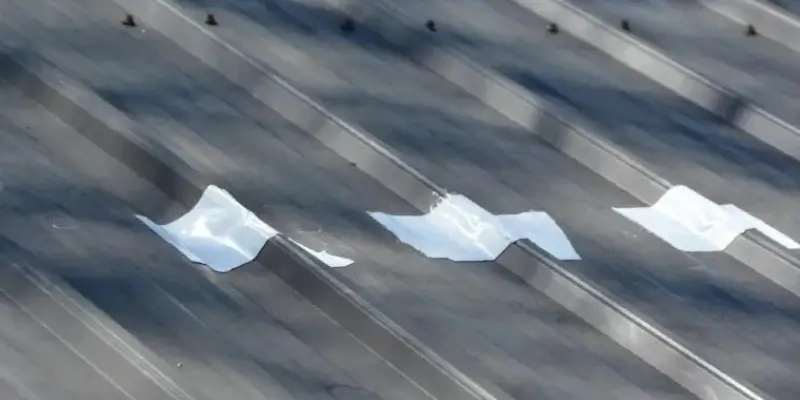Patching a metal roof might seem daunting, but with the right approach, it can be straightforward and effective. This guide will walk you through the essential steps to ensure your metal roof is repaired correctly, addressing common concerns like screw holes and the best repair practices. Let’s dive into making your metal roof as good as new.
What is Metal Roof Patching?
Metal roofs are durable, but they can still suffer damage from severe weather, rust, or wear and tear. Knowing how to patch these issues promptly can save you from more extensive and expensive roof repairs down the line.
Tools and Materials Needed
- Metal snips
- Wire brush
- Roofing cement
- Patching material (same as your roof)
- Drill and screws (for metal roofs)
- Sealant
Steps to Patch a Metal Roof
- Inspect the Roof: Identify all the areas that need repair. Look for rust, holes, or loose screws.
- Clean the Area: Use a wire brush to remove rust and debris. Ensure the surface is clean for the patch to adhere properly.
- Cut the Patch: The patching material should be the same type of metal as your roof. Cut it to size, ensuring it covers the damaged area completely, plus a few extra inches around.
- Apply Roofing Cement: Around the damaged area, apply a generous layer of roofing cement. This acts as an adhesive for the patch.
- Place the Patch: Carefully set the patch over the cemented area, pressing down firmly to remove any air bubbles.
- Secure the Patch: Drill screws around the perimeter of the patch to secure it in place. This step ensures the patch won’t lift or shift over time.
- Seal the Edges: Apply sealant around the edges of the patch to waterproof the repair. This step is crucial to prevent water from seeping under the patch.

Signs of Metal Roof Damage
Maintaining the integrity of your metal roof is crucial for the protection and energy efficiency of your home. With insights from Houston roofing experts, you can learn how to extend the longevity and durability of your metal roof. The first step in metal roof maintenance is identifying potential problems. Signs of damage can include:
- Visible Rust and Corrosion: These are early indicators that your roof requires rust treatment to prevent further damage.
- Loose or Missing Fasteners: Replacing fasteners is a simple yet critical repair to avoid more severe issues.
- Leaks and Water Damage: Prompt metal roof leak repair is essential to maintain the roof’s integrity.
- Physical Damage: Dents or punctures may require DIY or professional metal roof patching.
Understanding these signs and conducting regular metal roof inspections can prevent minor issues from escalating into costly repairs.
Metal Roof Maintenance Strategies
Regular maintenance is key to maximizing the lifespan and effectiveness of your metal roofing. Implementing the following strategies can ensure your roof remains in top condition:
- Rust Treatment: Apply coatings and perform rust removal to safeguard against corrosion.
- Waterproofing: Use high-quality sealant for metal roofs to prevent leaks and water damage.
- Cleaning: Adopt metal roof cleaning methods to remove debris and prevent blockages in your drainage system.
- Inspection: Schedule professional inspections to identify and address minor issues before they become significant.
Frequently Asked FAQs About Metal Roof Patching
How To Patch Screw Holes In Metal Roofs?
Screw holes can become a problem if they lead to leaks. To patch them:
- Remove any screws that are loose or damaged.
- Clean the hole with a wire brush.
- Apply roofing cement inside the hole.
- Insert a new screw that is slightly larger than the original, or place a patch over the hole if it’s too large for a screw.
- Seal around the screw or patch with sealant.
What Is The Best Way To Repair A Metal Roof?
The best way to repair a metal roof involves:
- Promptly addressing any signs of damage.
- Using materials that match your roof’s metal.
- Ensuring all patches are securely fastened and sealed.
What Are The Best Materials For Patching A Metal Roof?
The best materials for patching a metal roof are those that match the existing roof’s material and quality. Using the same type of metal ensures compatibility and prevents galvanic corrosion. Additionally, high-quality sealants and fasteners designed for metal roofing should be used to secure and waterproof the patch, ensuring a lasting roof repair.
How Can I Prevent Rust And Corrosion On My Metal Roof?
Preventing rust and corrosion involves regular maintenance and protective measures. Applying a rust-inhibiting primer and paint can protect exposed areas from moisture and environmental factors. Additionally, keeping the roof clean of debris and ensuring that water can freely flow off the roof will minimize the risk of rust. Regular inspections can also catch early signs of corrosion, allowing for prompt treatment.
DIY Metal Roof Patching vs. Professional Services
While DIY metal roof patching can be a cost-effective solution for minor repairs, some situations require the expertise of professional metal roofing services. Understanding when to tackle repairs yourself and when to call in the experts is crucial for maintaining your roof’s condition and safety.
Why Choose Hasid On The Roof Houston for Your Roof Repairs?
At Hasid On The Roof Houston, we understand the importance of maintaining a sturdy and leak-free roof. Our team of experts specializes in metal roof repairs, ensuring every patch is applied with precision and care. We believe in using the best materials and methods to extend the lifespan of your roof. Trust us to handle your roofing needs with professionalism and expertise.

